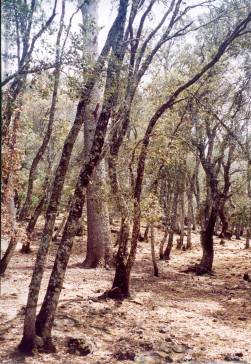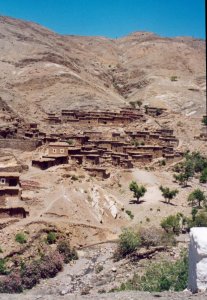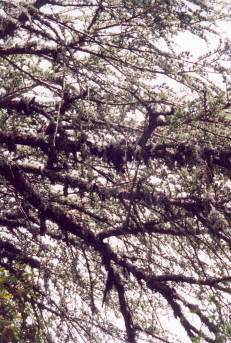
A SHORT NOTE ON THE ECOLOGICAL STATUS OF CEDARWOOD ATLAS: Cedrus atlantica (Endl.) Carr.
Pre-amble.
A small number of essential oil users have
questioned the advice in Cropwatch 5 (www.users.globalnet.co.uk/~nodice/
new/magazine/cropwatch5/cropwatch5.htm), and in my lectures to the
oil trade, that Cedarwood Atlas should be regarded as a potentially threatened
species, and that the use of aromatic commodities from this tree should be
actively discouraged. These queries apparently arise from a lack of easily
located Internet references on the subject (in spite of the fact that
deforestation in Morocco has proceeded at an alarming rate in recent times).
In practice, many essential oil users may rely on more limited and
potentially biased sales propaganda from their oil suppliers for ecological
information – although it is often difficult to find a classically trained
biologist or ecologist amongst their number. One such essential oil seller’s
website somewhat vaguely states: “Cedrus
atlantica from North Africa
which does need careful watching but the Morroccan (sic) government is not
stupid and the trees are under specific Royal patronage.” In my opinion, these
latter remarks gloss over the real facts, since, as is explained below, the
Atlas Mountains where Cedrus atlantica is naturally found, is the
principal contender for the Mediterranean Red Alert areas (see http://www.eco-action.org/dod/no10/empire-task2.htm),
10,000 km2 of Moroccan forest having disappeared between 1940 and
1982 (WWF, undated). UNICED (1994) & Thirgood (1984) reported that in the
last three decades 40% of Morocco’s forests had succumbed to desertification
or degradation. So, it is even more inexplicable that certifying agencies such
as Ecocert and the Soil Association have felt themselves able to endorse
aromatic commodities such as Cedarwood Oil Atlas which originate from these
critically endangered areas (see below) as qualifying for “organic” status.
The
identification of Sites of Biological and Ecological Interest
by the Water and Forest Directorate of the Forests and Water Ministry of
Morocco, and the launching of a World Bank/Global Environment Facility project
on biodiversity conservation by the Moroccan Government, are reported by WWF
(undated). They further report “the enlargement of the national protected
areas network, creation of new national parks, declare a number of these
priority sites as nature reserves, and improve the management systems of 13
areas, by establishing management plans, improving local capacity, and involving
local populations in nature resource management are amongst the goals”.
1. Cedrus
species: background.
The Cedrus genus
itself is generally divided into four separate species, but other
classifications have reduced the number to two. For example Cedarwood Atlas: Cedrus
atlantica (Endl.) Carr is classified by some workers as a geographical
subspecies of Cedar of Lebanon, and so becomes Cedrus libani subsp. atlantica
(Endl.) Batt. & Trabut. We can briefly summarise these classifications in a
table as follows:
| Common name | Botanical classification | Alternative botanical classification | Ecological Status |
|
Cedarwood
Atlas; Atlantic Cedar (Morocco,
Algeria) |
Cedrus
atlantica (Endl.)
Carr |
Cedrus
libani subsp. atlantica
(Endl.) Battand. & Trabut. |
Under
investigation for possible Red List entry: UNEP-WCMC |
| Cyprus Cedar
(Cyprus) |
Cedrus brevifolia (Hook
f.) Henry |
Cedrus libani subsp.
brevifolia (Hook f.) Meikle |
Rare:
restricted to 200 ha in Cyprus (Maheshwari 1970); or now 500 ha ? (Vidakovic
1991). |
|
Cedarwood
Himalayan; Deodar (Himalaya) |
Cedrus
deodara (D. Don) G. Don f. |
Cedrus libani subsp. deodara
(D. Don) Sell |
Extensively
exploited for railway
sleepers, construction timber, some furniture making and firewood uses. |
|
Cedar
of Lebanon (Lebanon
range & Asia Minor) |
Cedrus
libani A.
Rich |
Cedrus libanotica
Link |
Cedrus
libani
var. libani : low risk/near threatened
in Syria: IUCN (2004). Threatened in Lebanon:
Khuri et al. (2000) |
Table 1: True
Cedarwoods: common & botanical names and ecological status.
A detailed review of
the Cedarwood oils has been published (Burfield
2002, 2003a, 2003b).
2. Ecological status
of forests containing Cedrus atlantica.
The disappearing
Mediterranean conifer forests & eco-regions of N. Africa specifically extend
over N. Morocco, N. Tunisia and N.W. Algeria. A non-peer reviewed, but
informative paper by the World Wildlife Fund (WWF undated) describes
the conservation status of these conifer
forests as Critical / Endangered. The
conifer zone of Morocco is described in the same article as consisting largely
of Cedrus atlantica together with other species, according to location
– indeed the Atlas Cedar in strongly associated with Morocco’s ancient
forests in literature covering the last 5,000 years (Mardaga 1999). Many
of the taxa found in the Moroccan conifer forests are amongst some two hundred
included as threatened species in the IUCN Red List (2004) for Morocco; some
additional species (WWF undated) are tabulated below.
Tazi M. et al. present a modest program for the conservation
of plant genetic resources of Morocco in the face of the present genetic erosion
at http://apps3.fao.org/wiews/Morocco/Paper6.htm.
| Species | District | Status |
| Abies numidica |
Algerian
mountains |
Critically endangered |
| Abies marocana |
Moroccan Rif |
Critically endangered |
|
Pinus nigra ssp. mauretania |
Moroccan Rif, Algerian
Djurdura |
Critically endangered |
|
Pinus pinaster ssp. hamiltonii
var. maghrebiana |
Moroccan Rif & Middle
Atlas |
Critically endangered |
Table 2. – Other Endangered Species in the N. African Conifer Forests
(after WWF: undated)
The status of cedarwood
forests is further explained in a 1997 document on Morocco’s Protected Areas
Management Project which can be seen at http://www.gefweb.org/wprogram/mor-anxa.doc,
which describes the Ifrane National park in the Moyen-Atlas central (54,000 ha)
essentially based on Cedrus atlantica. (Benabid 2000 reports C.
atlantica with Quercus faginea,
Quercus rotundifolia, Pinus
pinaster var. maghrebiana & Juniperus thruifera amongst
the 600-700 endemic spp.)

Mixed forest area in High Atlas
The Bou Iblane I area (12,000 hectares) is
similarly described (part of site is Cedrus
atlantica mixed with green oak Quercus
rotundifolia and part with the juniper tree species Juniperus
thurifera), which is legally unprotected:
young cedar trees are uprooted to provide winter
grazing for livestock and juniper forerst is degrading from
overgrazing. The Jbel Tichoukt area (12,000 ha), also with
cedar forest threatened by overgrazing by livestock, is further
described.
In many areas, in addition to overgrazing threats, the uncontrolled gathering of firewood/illegal logging by local peoples whose needs are not being met, is threatening the survival of Cedarwood Atlas trees; other threats include fire. WWF (undated) refers to the transformation in Berber life from a semi-Nomadic existence to a more settled permanence as putting an un-met requirement for fuel, as being a factor in illegal logging.

Photo A Berber Village in the High Atlas
A thesis on hearth
fuel acquisition in the Imnane valley in Morocco’s High Atlas at http://peacecorps.mtu.edu/DownsCM.pdf
may provide some insight on such communities that depend on wood fuels, to the
reader. However these problems are longstanding: a 1988 article on Toubkal
National Park at http://ims.wcmc.org.uk/IPIECA2/sitesht/1120v.html
refer to these very same factors (uncontrolled herding, illegal timber &
wood extraction, fire) with little/no active conservation management being
evident. Ciani A.C. & Castillo P. (undated) describe
a dramatic increase in forest degradation due to overgrazing since
the 1970’s (including the cutting of vegetation from cedar trees by axe which
eventually kills the tree which causes very severe damage). The authors also
describe the effects of the 1991-1996 drought in the Middle Atlas, where the
water table dropped severely, and debarking of cedar trees by Barbary macaques
further degraded the cedar forest.
Specific information
on illegal logging is difficult to obtain; Hmamouchi (2001a) refers to the
illegal felling of trees and illegal clearing as amongst
the principal obstacles to the development of plant medicine in Morocco.
Ciani A.C. & Castillo P. (undated) report that the legal logging of cedar
trees by Eaux et Forets Dept. of the Ministry of Agriculture proceeds according
to management plans, but the rate of extraction is based on the over-optimistic
capability of existing forest regeneration policies.
Benabid (2000) also documents the following areas
as containing Cedrus atlantica trees: Bou Naucer (high mountain region in
the Moyen Atlas Oriental covering 14,000 ha); Parc Nationale de Talassemtane (Rif
Central Occidental covering 60,000 ha); Parc Nationale de Tazekka (northern part
of Moyen Atlas Oriental 12,000 ha); Parc Nationale du Haute Atlas Oriental
(49,000 ha). Whilst Cedarwood Atlas trees appears to
be well conserved in specific areas of parkland, the ecosystem is very fragile -
often the margins are subject to degradation by erosion, demineralisation,
dehydration, desertification etc. resulting in areas of complete desolation [Pujos
(1986); Benabid (1982) & (1985); M’hirit (1982); Quezel et al.
(1987) – all through Benabid (2000)]. Benabid (2000) for example describes the
areas of the Moyen Atlas Plissé and High Atlas Oriental regions as ecologically
fragile, subject to desertification, and unfavourable for Cedars, those present
often being found dead or damaged.
3.
Cedarwood Commodities: Cedarwood Oil Atlas
is produced by steam distillation or high pressure steam distillation of the
wood at a yield of 3-5% from the branches, waste wood, and especially the
sawdust of the pyramidal Cedrus atlantica tree itself, which has not been
described in detail here so far. It is an ascendingly branched tree, with
evergreen needles, which can grow up to 50m. or exceptionally to 65m. at an
elevation of 1400-2500m. in humid and cold subhumid zones. It survives on
several different types of soil in the 133,653 hectares of Cedar forest
(according to Mardaga 1999) in the Middle Atlas, Rif central and Grand Atlas
Oriental, and the Middle Atlas Oriental areas of Morocco, where Cedar forest
might constitute some 2.8% of the total area of Moroccan forest (Mardarga 1999).
The tree also grows in N.W. Algeria, scattered widely over 300 km2 in
the Tellien Atlas. Cultivars of the tree have been imported into N. America
(especially into milder parts of British Columbia) & Canada as ornamentals -
the cultivar C. atlantica f. glauca (Blue Cedar) is especially
admired for its blue foliage. It is used as a reforestation tree in France,
Italy, Bulgaria etc., but it is susceptible to pest attacks when grown in Europe
[Ciani & Castillo (undated)].
Essential oil
production in Morocco was estimated at 7 tons per annum by Lawrence (1985) but
levels of Cedarwood Atlas concrete production tonnage (solvent extraction
of the wood by cyclohexane or other solvents – benzene was formerly used) are
unrecorded. Cedarwood Atlas concrete (anomalously called a “resinoid”)
does find some use in perfumery because of its good fixative properties and
finer odour than the oil (Arctander 1960). The more valued “absolute”
is produced from the concrete by fractional distillation. The essential oil
nowadays has limited uses in perfumery because of its strong detracting urinic
odour compared with the finer notes of the oil of Cedarwood Virginian. However,
a 1936 edition of Poucher (Poucher 1936) desribes a mimosa aspect to the oil,
and indicates that the double rectified oil of Cedrus atlantica was, at
the time, considered of use in soap perfumery, the terpeneless oil useful in
perfumery and the solvent extracted resinoid useful in soap fragrancing in spite
of its dark colour. A Moroccan medical plant reference book (Hmamouchi M. 2001)
only describes the traditional use (wood, leaves) as an anti-inflammatory for
rheumatism, but warns of neurotoxic effects. Gattefossé reports on Massey’s
therapeutic study of Cedarwood Atlas and its uses in venerology a centaury ago (Gattefossé
1937); the oil has since been successfully marketed into aromatherapy, where it
is employed for its’ antiseptic, anticatarrhal, circulatory stimulant and
expectorant properties.
The
Cedarwood Atlas tree has been important in the socio-economy of Morocco, being
suitable for furniture making, carpentry, construction work, and by
dry-distillation, for tar-making. Benabid (2000) also mentions that the leaves
(needles) are using in tanning. Like all cedarwoods, the wood it is fragrant,
insect repellent and rot-resistant due to the essential oil content. However it
is not known with any certainty, what level of extra pressure on the shrinking
conifer forests, or the wider environmental impact implications that the
continued extraction of essential oil & resin from the tree has had.
Further, the skin sensitivity problems associated with the production of
fragrant lichen products from oakmoss (Evernia
prunastri)
& treemoss (Pseudoevernia
furfuracea
mixed
with Usnea
spp.)
qualities which
are used in perfumery, have led to an much-increased demand for Moroccan Cedarmoss
extracts (from the lichen Evernia furfuracea),
which grow on, and are gathered from, Cedarwood Atlas trees.

Heavy growth of Cedarmoss
on a
The
author has not been able to find any damage/impact data relating to the
increased rate of gathering of Cedarmoss from Cedarwood forests; however Ciani
A.C. & Castillo P. (undated) describe the economic production of this
activity- and other cedar forest activities such as essential oil production,
honey-bee breeding and ethno-medicinal production - as being low.
Margot
(1999) in a major work on the Moroccan forest system describes the explains the
necessity for silviculture in Morocco’s natural forest and describes schemes
of regeneration for Cedarwood Atlas in plantations stretching over 120 years and
involving thinning developing trees down from a rate of 5,000 per hectare down
to an eventual 100 per hectare - by which time the trunk diameter is 30cm (at
120 years plus). As we have seen in previous Cropwatch reports with similar
long-maturing tree schemes (Sandalwood East Indian, Rosewood Brazilian) (see http://www.users.globalnet.co.uk/~nodice/)
these plans for sustainability may be commendable in some respects, but may have
too much built-in vulnerability to be relied on totally.
Conclusion.
It is apparent
that stricter management of the critically endangered and rapidly diminishing
conifer forest areas of Morocco, in conjunction with meeting the basic needs of
local people, is still an urgent priority. Meanwhile the exploitation of
shrinking conifer forests for Cedarmoss, Cedarwood oil Atlas, its resinoid and
absolute, by the aroma trade should be halted right now, in my opinion, until a
comprehensive environmental impact study is available, the area is adequately
conserved, and adequate resources for natural regeneration are available.
Glossary.
An
acre = 4,046 square metres (m2)
= 0.405 hectare
A
hectare = 10,000 square metres (m2)
= 2.471 acres = 0.01 square
A square kilometre = 1,000,000 square metre = 100 hectares = 247.105381
Acres = 0.386102 square miles.
References.
Arctander S. (1960) Perfume & Flavour Materials of Natural Origin
Elizabeth NJ (USA).
Benabid A. (1982) Etudes phytoécologique, biogéographique, et dynamique
des associations et séries sylvatiques du Rif occidental (Maroc). Thèse
Docr. ès- Sc. Fac. Sci. et Tech. St-Jérôme, Aix-Marseille III, 199p. +
Annexes.
Benabid A. (1985) Les Ecosystèmes forestiers Maricaines: Diversité, biogégraphie
et degradation. Forêt méditerranéenne, Marseillle, T.7.
Benabid A. (2000) Flore et Écosystèmes du Maroc Éditions Ibis
Press, Paris, 2000.
Burfield (2002) “Cedarwood Oils – Part One” Aromatherapy Times
Vol 1(55) Winter 2002 pp 14-15.
Burfield (2003a) “Cedarwood Oil - Part 2” Aromatherapy Times
Spring 2003 Vol 1(56) p14-16.
Burfield (2003b) “Cedarwood Oil – Part 3: Therapeutic Properties” Aromatherapy
Times, Summer
2003 Vol 1(57) pp 16-18.
Ciani A.C. & Castillo P. (undated) “The Desertification Process in the
last natural forest of the Southern Meditteranean Region” – see http://www.psy.unipd.it/~eto/testi/articoli/cretepau.html
Gattefossé R.-M. (1937) Aromathérapie
les Huilles Essentielles Hormones Végétales Gardot et Cie Paris 1937.
Hmamouchi M. (2001) Les Plantes
Medicinales et Atomatiques Marocaines (pvt publicn) 2nd edn 2001
p67.
Hmamouchi M. (2001) ibid p25.
IUCN (2004): Conifer
Specialist Group 1998. Cedrus libani var. libani. In: IUCN 2004. 2004
IUCN Red List of Threatened Species. <www.redlist.org>.
Khuri S.
“Conservation of the Cedrus
libani populations in Lebanon: history, current status and experimental
application of somatic embryogenesis” Biodiversity and Conservation 9
(9): 1261-1273, September 2000.
Lawrence
B.M. (1985): “A review of the world production of essential oils (1984)” Perf.
Flav. 10(5) 1-16.
Maheshwari P & Biswas C. (1970)
“Botanical Monograph No. 5 - Cedrus” CSIRA New Delhi p3.
Mardaga (1999) Le
grand livre de la Foret Morocaine pub. P.
Amardaga Spimont (Belgium) 1999.
M’hirit O. (1982) Etude écologique et
forestière des cédraies du Rif Marocain. Ann. Rech. Forest. No. 22.
S.R.F. Rabat.
Poucher W.A. (1936) Perfumes,
Cosmetics and Soaps Vol 1 Chapman & Hall, London 4th edn 1936
p 49-50.
Pujos A. (1966) “Les milieux de la
cedraine Marocaine” Ann. Rech. Forest., Rabat, 8, 283.
Quezel P., Barbero M. & Benabid
A. (1987) “Contribution à l’étude des groupements forestiers et préforestiers
du Haut Atlas oriental (Maroc)” Ecol. Medit. Marseille, 13(1/2),
107-117.
Tazi M. , Birouk A. , Mellas H. & Maghnouj M. “Plant genetic resources
conservation and documentation in Morocco” – see http://apps3.fao.org/wiews/Morocco/Paper6.htm
Thirgood, J.V.
(1984) The Demise of Barbary Macaque Habitat - Past and Present Forest
Cover of the Maghreb. pp 19 - 69 in The Barbary Macaque. A case study in
conservation. J.E. Fa, ed. New York, Plenum Press, 1984.
NCED (1994) United Nation convention
to combat desertification in those countries experiencing serious drought and/or
desertification, particularly in Africa. New York, 1994 [through Ciani A.C.
& Castillo P. (undated) above].
Vidakovic, Mirko (1991) Conifers: morphology and variation. Translated
from Croatian by Maja Soljan. Croatia: Graficki Zavod Hrvatske.
WWF (undated) – see: http://www.worldwildlife.org/wildworld/profiles/terrestrial/pa/pa0513_full.html